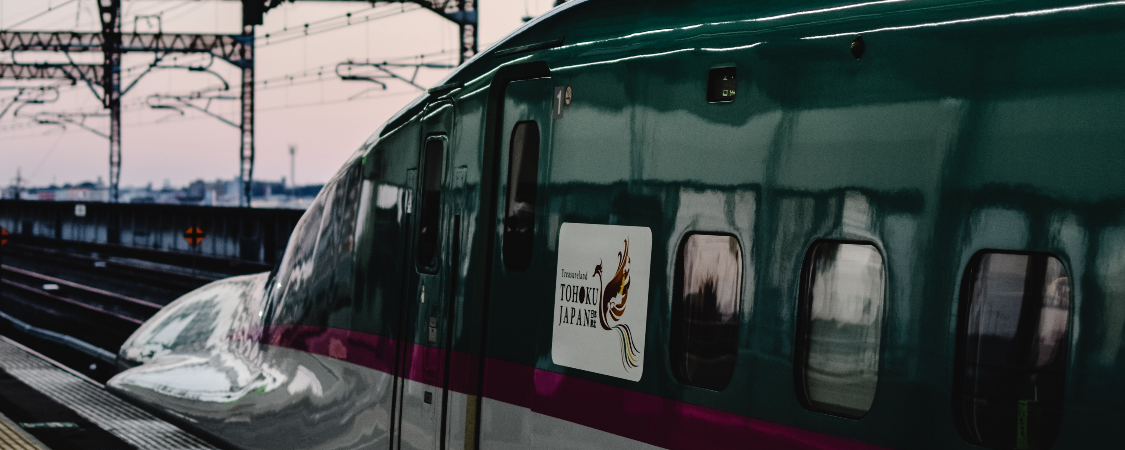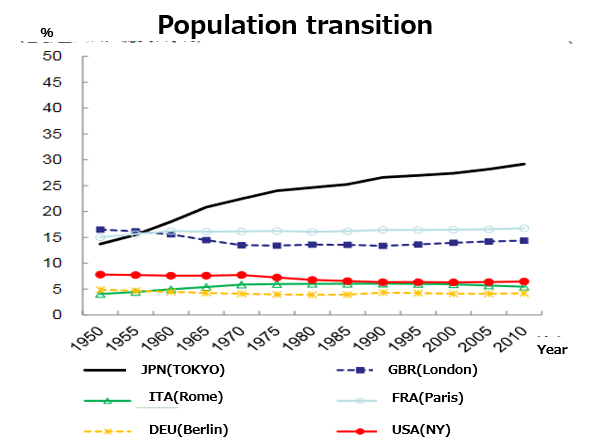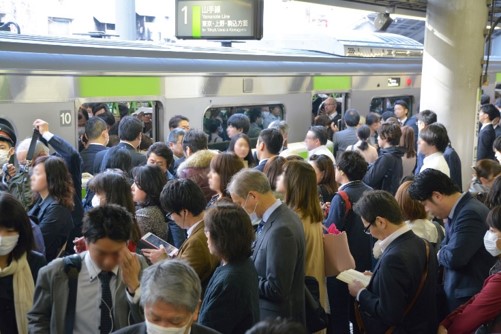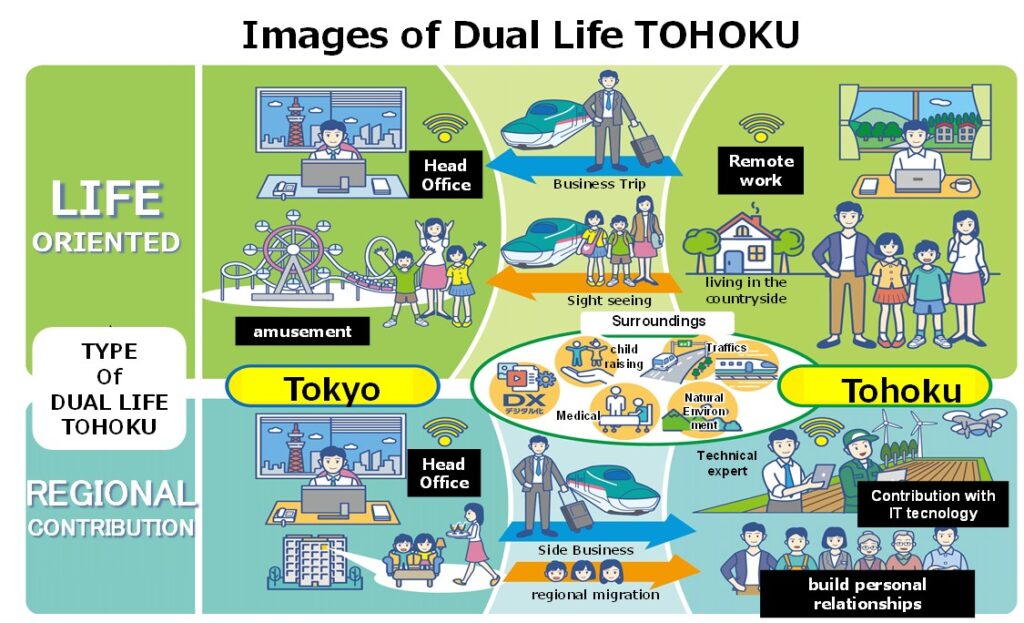COVID-19 is raging across Japan. Now that there is an remote-work environment in place, and because people want to avoid contact with others, we are starting to move away from those famous Tokyo jam-packed trains, and are changing our views about life in the rural areas.
Comparing the centralization of Japan’s capital with the rest of the world
The United States’ center of politics is in Washington, but its economic centers are within places like New York, Chicago, and California, so the population is distributed amongst different industries. In Europe, there’s Germany with industry clusters in every region, and in Italy, there’s more than just Rome; there’s Milan, Florence, and other major cities where the population is distributed. In France, around 20% of their general population lives in central Paris (Île-de-France), so Paris is a very centralized capital city.
How about Japan? Around 30% of the general population (around 35 million people) live in Tokyo or the greater Tokyo area. Look at the following graph. In Japan, people have always been gathering in Tokyo.
People from Tohoku have continued to move to Tokyo
If you look at the graph, the acceleration of Tokyo’s centralization began in the 1960s. Japan’s economy experienced a fast-paced expansion around this time, and in 1968, our GNP reached the second-highest in the world after the USA. This is when we were called the Japanese miracle. Of course, this meant that many workers were needed in Tokyo, and the people in the rural regions knew that if they went to Tokyo they could find work that paid well.
Many people left Tohoku by train looking for work in Tokyo. Those people were called “golden eggs” and were the ones that took a main role in the growth of the Japanese economy. This is more than 50 years ago now, but if you look at the graph, you’ll see that things haven’t really changed in this composition.
In a recent study, Tohoku made up 20% of the general movement of population into the greater Tokyo area. Most of those people are young; especially young women.
Japan has the second worst birthrate and oldest population in the world. This double whammy of a population problem means that the rural regions are rapidly being abandoned, leaving many challenges in their wake. But still the flow of people to Tokyo continues.
Here you can see some exhausted people headed home during the rush hour trains running morning and night. Classic Japanese salaryman stuff!
The ever-increasing flow of people back to the rural areas during COVID-19
The centralization of Tokyo hasn’t let up, even when the rush hour is hell, living conditions are rough, and we know the risks of such centralization especially since the 2011 Tohoku earthquake. All of our business partners are in Tokyo, and it’s got so many opportunities for work and play – so much so that the Keidanren (Japan Business Federation) has analyzed the situation as “everyone has their own reasons” for being in Tokyo.
However, in 2020 that all changed. Because of COVID-19, an environment was quickly set up for remote work, and because people want to avoid contact with others, we’re changing our views about living in rural areas. In a recent study, 50% of people living in Tokyo have an interest in living in a region outside of Tokyo. Also, since 2018, the central government has been promoting side work, and as a result, many are saying that they’d like to continue their main work in Tokyo while doing side work in the rural regions.
Remote work has become a fact of life even in Japan. I’d love to do it myself but…
Dual Life TOHOKU – Diverse living conditions, diverse working conditions in Tohoku
In order to give hold to this trend, the Tohoku Economic Federation has presented “Five proposals for post-COVID-19). To the people living in Tokyo, looking towards a post-COVID society, they’ve included a message that Tohoku is the best place for many different types of living and working conditions.
The main point of the proposal is the concept of Dual Life Tohoku, which promotes different styles of living and working in Tohoku. Within, there are two patterns suggested. The first is to move your whole family here, mainly working remotely, and going to Tokyo only when needed – a “Living Environment First Model”. The second is for people who can’t leave Tokyo for various reasons like housing and education, but would like to use their skills to do side work in Tohoku – a “Regional Contribution Model.” We decided to call these “Dual Life TOHOKU.”
We want more people to think back to their hometowns
There’s another message in this proposal. I told you that there are a lot of people in Tokyo with ties to Tohoku. Thanks to COVID, we are spending more time at home, but it has given us time to relax with our families, and think about our parents and friends living far away, in our home towns in Tohoku.
We’re all busy with work and family, and rarely have a moment to think about our hometowns. But we hope this is an opportunity to reflect and think about how our parents and hometowns are doing. Our message is that this is a time to come back and rebuild our ties with our hometowns.
2021 – from Tokyo to the rural regions. It may be an epoch-making year that reverses the trend. I myself plan to work in Sendai and contribute to my hometown in Aomori. I’ll try my hardest!
Japanese
日本のトレンドになるか、東京から地方への人の流れ新型コロナウイルス感染症は日本でも猛威を振るっています。リモートワークの環境が整ったことや、人と人との接触を避ける観点から、いま、日本では、東京名物のjam-packed trainをやめて、改めて「田舎」で暮らす良さが見直されています。
世界と日本の一極集中の比較
アメリカでは、政治はワシントンDC、経済はニューヨーク、シカゴ、カリフォルニア等、産業別に人口が分布しています。ヨーロッパでも、ドイツは各地に産業クラスターがありますし、イタリアもローマだけでなくミラノにフィレンツェと、多様な都市に人口が分散してます。フランスと言えばパリですが、パリを中心とした都市圏(Île-de-France)に、総人口の20%が集中しています。フランスは、パリ一極集中ですね。
では日本では?日本は、東京を中心とした首都圏に、総人口の30%(約3,500万人)が暮らしています。グラフを見てください。日本はずっと東京に人が集まり続けているのです。
図1 世界の主要都市人口が総人口を占める割合
東京に人材を送り続けた東北地域
グラフを見ると日本で東京一極集中が加速したのは1960年代以降だということが分かります。この頃、日本は高度経済成長期に入り、1968年にはGNPが米国に続く第2位となりました。東洋の奇跡(Japanese miracle)と呼ばれた時代です。当然、日本の中心、東京ではたくさんの働き手が必要で、地方の人にとっては「東京に行けば儲かる仕事がある」時代でした。
東北からは、多くの人たちが仕事を求めて列車で東京に向かいました。そのような人たちは、「金の卵」と呼ばれて日本の経済成長の中核を担ったのです。50年も前の話ですが、グラフを見れば、今でもこの構図が変わっていないことが分かります。
最近の調査では、首都圏への人口流入全体の2割を東北が占めていることが分かっています。その多くは若者、特に若い女性です。
少子化は世界No.2、高齢化は世界No.1と、少子高齢化が進む日本で、田舎は過疎が急速に進んでおり、様々な課題が浮き彫りになってきていますが、「地方から東京へ」の流れはいまだに止まりません。
図2 朝晩のrush hour trainで疲労困憊で家に帰るお父さんの姿は、すっかり日本人ビジネスマンの代名詞になりましたね。
コロナ禍で高まりつつある「東京から地方へ」の流れ
通勤ラッシュが地獄でも、自然環境が悪くても、東日本大震災を経験して一極集中はリスクがあることが分かっても、東京一極集中は是正されませんでした。取引先が東京に集中していること、就業機会の多さや充実した娯楽・サービスがあるなど、東京にいることには「それなりの理由がある」と経団連は分析しています。
ただ、2020年はこの状況が一変しました。コロナ禍をきっかけにリモートワークの環境が急速に整ったことや、人と人との接触を避ける観点から、改めて「地方で暮らす良さ」が見直されつつあります。最近の調査では、東京で暮らす人の5割が地方暮らしに興味があるという結果が示されています。また、2018年から政府が副業・兼業を推進するようになったことも後押しし、東京で働きながら「地方で副業してみたい」という声も多くなってきました。
図3 リモートワークイメージ
デュアルライフ東北 多用な暮らし、多様な働き方を東北で
この流れを確かなものにするために、東北経済連合会が「ポストコロナ・5つの提言」を発表しました。東京で暮らす人たちに対して、ポストコロナを見据えた社会で、多様な暮らし、多様な働き方をするなら東北が最適ですよ、というメッセージを込めたものです。
提言のポイントは、多様な暮らし、多様な働き方を東北でしましょうという「デュアルライフ東北」です。この中では、2つのパターンを提案しています。1つ目は、家族まるごと移住して、基本はリモートワーク、必要な時だけ東京に出張する「暮らし重視型」。2つ目は、住宅・教育など様々な理由で東京を離れるわけにはいかないけれど、自分のノウハウを生かして東北で副業する「地域貢献型」。私たちはこれをデュアルライフ東北と呼ぶことにしました。
故郷との関係を見直す人を増やしたい
この提言には、もう一つ意味が込められています。東京には東北にゆかりのある人たちがたくさんいることは既にお話したとおりです。コロナ禍により家で過ごすことを余儀なくされましたが、家族とゆっくり過ごしたり、遠くに住む両親や友人、故郷のことを考える時間を与えてくれました。
仕事に家庭に忙しく、これまで故郷から目を背けてきたあなたへ。実家のご両親は息災ですか?あなたを育ててくれた故郷は元気でしょうか?今こそ、故郷との関係を見直すチャンスですよ。ぜひこれを機に帰ってきてください。これがもう一つの大事なメッセージです。
2021年は東京から地方へ、人の流れが変わるepoch‐makingな1年になるかもしれません。私も、今年から、仙台で仕事をしながら故郷の青森に貢献する仕事もしていく予定です。I'll try my hardest!
図4 デュアルライフ東北のイメージ図






-195x124.jpg)
